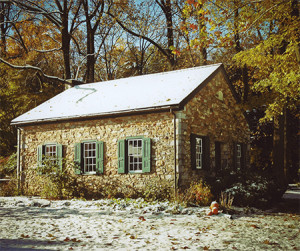In the Annals of Pennsylvania written by John F. Watson in 1854, and from the collection of UM historian, Elizabeth Ellis Deliberato, many variations of temperature are recorded.
Watson wrote “On Jan. 2, 1790, there was such an open winter as the present has not been known with boys bathing in the river as if it were summer.”
“Jan. 21, 1795, the sky continued almost invariably without a single cloud for a time long past. Even flies were seen a few days ago.”
“March 8, 1800, snow fell without intermission for twenty-five hours with over two feet upon a level. The climate has undergone a material change.”

Roberts School photographed after a freak snowstorm blanketed the area causing major power outages on October 31, 2011. The year 2011 also included an earthquake and a hurricane. (Courtesy of Vytas Masalaitis.)
“Mild winters occurred in 1790, 1802, 1810, 1824 and 1828.”
“The 8th of May, 1803 was a remarkable day. It snowed so heavily as to make a wonderful breaking of the limbs of trees then in full leaf. The roads were filled with broken limbs.”
“On June 5, 1816 a severe frost happened. So severe as to kill the beans. Whole fields of corn were destroyed.”
“During Jan, 1817, there were many thunder and lighting storms.”
“Oct. 25, 1823 was a very dark day. There was great darkness at 9 o’clock a.m. as to make candlelight desirable. At Norristown, they were obliged to use candles and printers were compelled to print by candlelight. It was frightening. There was a storm at an earlier hour with thunder and rain. It was widespread darkness.”
“The winter of 1827-28 most remarkable for its mildness. No snow or frost and the plough enabled to cut the furrows. Mild rain everywhere instead of snow. The gazettes teem with notices of the unusual mild weather. The mildness of winter prevented the unusual storing of ice for the fish markets.”
Excerpt from the King of Prussia Courier, Wednesday, March 21, 1990 article “Unusual weather has a history in UM” by Ed Dybicz.
